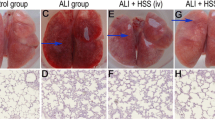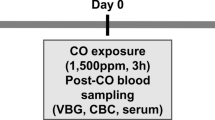Abstract
The aim of this study was to investigate the effects of caffeic acid phenethyl ester (CAPE) in the lungs by biochemical and histopathological analyses in an experimental isolated lung contusion model. Eighty-one male Sprague–Dawley rats were used. The animals were divided randomly into four groups: group 1 (n = 9) was defined as without contusion and without CAPE injection. Group 2 (n = 9) was defined as CAPE 10 μmol/kg injection without lung contusion. Group 3 (n = 36) was defined as contusion without CAPE-administrated group which consisted of four subgroups that were created according to analysis between days 0, 1, 2, and 3. Group 4 (n = 27) was defined as CAPE 10 μmol/kg administrated after contusion group divided into three subgroups according to analysis on days 1, 2, and 3. CAPE 10 μmol/kg was injected intraperitoneally 30 min after trauma and on days 1 and 2. Blood samples were obtained to measure catalase (CAT) and superoxide dismutase (SOD) activities and level of malondialdehyde (MDA) and for blood gas analysis. Trace elements such as zinc and copper were measured in serum. The lung tissue was also removed for histopathological examination. Isolated lung contusion increased serum and tissue SOD and CAT activities and MDA levels (p < 0.05). Both serum and tissue SOD, MDA, and CAT levels on day 3 were lower in group 4 compared to group 3 (p < 0.05). Further, the levels of SOD, MDA, and CAT in group 4 were similar compared to group 1 (p > 0.05). CAPE also had a significant beneficial effect on blood gases (p < 0.05). Both serum zinc and copper levels were (p < 0.05) influenced by the administration of CAPE. Histopathological examination revealed lower scores in group 4 compared to group 3 (p < 0.05) and no significant differences compared to group 1 (p > 0.05). CAPE appears to be effective in protecting against severe oxidative stress and tissue damage caused by pulmonary contusion in an experimental setting. Therefore, we conclude that administration of CAPE may be used for a variety of conditions associated with pulmonary contusion. Clinical use of CAPE may have the advantage of prevention of pulmonary contusion.




Similar content being viewed by others
References
Cohn SM (1997) Pulmonary contusion: review of the clinical entity. J Trauma 42:973–979
Cohn SM, Zieg PM (1996) Experimental pulmonary contusion: review of the literature and description of a new porcine model. J Trauma 41:565–571
Garden DL, Granger DN (2000) Pathophysiology of ischaemia–reperfusion injury. J Pathol 190:255–266
Grunberger D, Banerjee R, Eisinger K, Oltz EM, Efras L, Coldwell M (1998) Preferential cytotoxicity on tumor cells by caffeic acid phenethyl ester isolated from propolis. Experientia 44:230–232
Su ZZ, Lin J, Grunberger D, Fisher PB (1994) Growth suppression and toxicity induced by caffeic acid phenethyl ester (CAPE) in type 5 adenovirus transformed rat embryo cells correlate directly with transformation progression. Cancer Res 54:1865–1870
Sud’ina GF, Mirzoeva OK, Pushkareva MA, Korshunova GA, Sumbatyan NV, Varfolomeev SD (1993) Caffeic acid phenethyl ester as a lipoxygenase inhibitor with antioxidant properties. FEBS Lett 329:21–24
Laranjinha J, Vieira O, Madeira V, Almeida L (1995) Two related phenolic antioxidants with opposite effects on vitamin E content in low density lipoproteins oxidized by ferrylmyoglobin: consumption vs regeneration. Arch Biochem Biophys 323:373–381
Kimura Y, Okuda H, Okuda T, Hatano T, Agata I, Arichi S (1985) Studies on the activities of tannins and related compounds from medicinal plants and drugs. VII. Effects of extracts of leaves of Artemisia species, and caffeic acid and chlorogenic acid on lipid metabolic injury in rats fed peroxidized oil. Chem Pharm Bull 33:2028–2034
Zheng ZS, Xue GZ, Grunberger D, Prystowosky JH (1995) Caffeic acid phenethyl ester inhibits proliferation of human keratinocytes and interferes with the EGF regulation of ornithine decarboxylase. Oncol Res 7:445–452
Lorne E, Zmijewski JW, Zhao X et al (2008) Role of extracellular superoxide in neutrophil activation: interactions between xanthine oxidase and TLR4 induce proinflammatory cytokine production. Am J Physiol Cell Physiol 4:C985–C993
Prasad AS (2008) Clinical, immunological, anti-inflammatory and antioxidant roles of zinc. Exp Gerontology 43:370–377
Shankar AH, Prasad AS (1998) Zinc and immune function: the biological basis of altered resistance to infection. Am J Clin Nutr 68:447S–463S
Puig S, Thiele DJ (2002) Molecular mechanisms of copper uptake and distribution. Curr Opin Chem Biol 6:171–180
Krishnan R, Bruce A, Jadwiga D, Cristi J, Patricia M, James A, Paul R (2005) A rat model of ısolated bilateral lung contusion from blunt chest trauma. Anest Analg 1001:1482–1489
Lowry OH, Rosebrough NJ, Randall RJ (1951) Protein measurement with the Folin phenol reagent. J Biol Chem 182:265–268
Calikoglu M, Tamer L, Sucu N (2003) The effects of caffeic acid phenethyl ester on tissue damage in lung after hindlimb ischemia-reperfusion. Pharmacol Res 48:397–403
Ogeturk M, Kus I, Colakoglu N, Zararsiz I, Ilhan N, Sarsılmaz M (2005) Caffeic acid phenethyl ester protects kidneys against carbon tetrachloride toxicity in rats. J Ethnopharmacol 97:273–280
Iraz M, Ozerol E, Gulec M, Tasdemir S, Idiz N, Fadillioglu E, Naziroglu M, Akyol O (2006) Protective effect of caffeic acid phenethyl ester (CAPE) administration on cisplatin-induced oxidative damage to liver in rat. Cell Biochem Funct 24:357–361
Rossi A, Longo R, Russo A, Borrelli F, Sautebin L (2002) The role of the phenethyl ester of caffeic acid (CAPE) in the inhibition of rat lung cyclooxygenase activity by propolis. Fitoterapia 73:S30–S37
Cantin AM, Noth SL, Fells GA, Hubbart RC, Crystal RG (1987) Oxidant-mediated epithelial cell injury in idiopathic pulmonary fibrosis. J Clin Invest 79:1665–1673
Afanas TB, Cheremisina ZP, Abramova NE, Korkina LG (1995) Study of antioxidant properties of metal aspartates. Analyst 120:859–862
Zimmerman GA, Renzetti AD, Hill HR (1983) Circulating polymorphonuclear leukocyte activity in patients with the adult respiratory distress syndrome. Implications for pulmonary vascular injury. Chest 83:87S–89S
Bergendi L, Benes L, Durackova Z, Ferencik M (1999) Chemistry, physiology and pathology of free radicals. Life Sci 65:1865–1874
Koltuksuz U, Ozen S, Uz E, Aydin M et al (1999) Caffeic acid phenethyl ester prevents intestinal reperfusion injury in rats. J Pediatr Surg 34:1456–1462
Esterbauer H, Cheeseman KH (1990) Determination of aldehydic lipid peroxidation products: malonaldehyde and 4-hydroxynonenal. In: Packer L, Glazer AN (eds) Methods in enzymology, vol 186, Oxygen radicals in biological systems. Academic, New York, pp 407–421
Türüt H, Ciralik H, Kilinc M, Ozbag D, Imrek SS (2009) Effects of early administration of dexamethasone, N-acetylcysteine and aprotinin on inflammatory and oxidant-antioxidant status after lung contusion in rats. Injury 40:521–527
Author information
Authors and Affiliations
Corresponding author
Rights and permissions
About this article
Cite this article
Sırmalı, M., Solak, O., Tezel, C. et al. Comparative Analysis of the Protective Effects of Caffeic Acid Phenethyl Ester (CAPE) on Pulmonary Contusion Lung Oxidative Stress and Serum Copper and Zinc Levels in Experimental Rat Model. Biol Trace Elem Res 151, 50–58 (2013). https://doi.org/10.1007/s12011-012-9505-7
Received:
Accepted:
Published:
Issue Date:
DOI: https://doi.org/10.1007/s12011-012-9505-7




